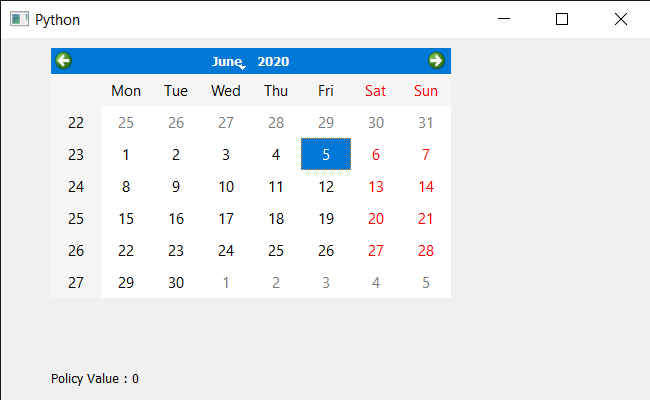PyQt5 QCalendarWidget – 获取它的上下文菜单策略
在本文中,我们将了解如何获取 QCalendarWidget 的上下文菜单策略。上下文菜单策略告诉日历将如何显示上下文菜单,日历有许多可用的策略,如 NoContextMenu、PreventContextMenu 等。默认情况下,日历具有 DefaultContextMenu 作为上下文策略,尽管我们可以在 setContextMenuPolicy 方法的帮助下更改它。
In order to do this we will use contextMenuPolicy method with the QCalendarWidget object.
Syntax : calendar.contextMenuPolicy()
Argument : It takes no argument
Return : It return Content Menu Policy object but when printed it shows the associated value of policy.
下面是实现
Python3
# importing libraries
from PyQt5.QtWidgets import *
from PyQt5 import QtCore, QtGui
from PyQt5.QtGui import *
from PyQt5.QtCore import *
import sys
class Window(QMainWindow):
def __init__(self):
super().__init__()
# setting title
self.setWindowTitle("Python ")
# setting geometry
self.setGeometry(100, 100, 650, 400)
# calling method
self.UiComponents()
# showing all the widgets
self.show()
# method for components
def UiComponents(self):
# creating a QCalendarWidget object
self.calendar = QCalendarWidget(self)
# setting geometry to the calendar
self.calendar.setGeometry(50, 10, 400, 250)
# setting context menu policy
self.calendar.setContextMenuPolicy(Qt.NoContextMenu)
# creating a label
label = QLabel(self)
# setting geometry
label.setGeometry(50, 280, 420, 120)
# making it multi line
label.setWordWrap(True)
# getting context menu policy
value = self.calendar.contextMenuPolicy()
# setting text to the label
label.setText("Policy Value : " + str(value))
# create pyqt5 app
App = QApplication(sys.argv)
# create the instance of our Window
window = Window()
# start the app
sys.exit(App.exec())输出 :
